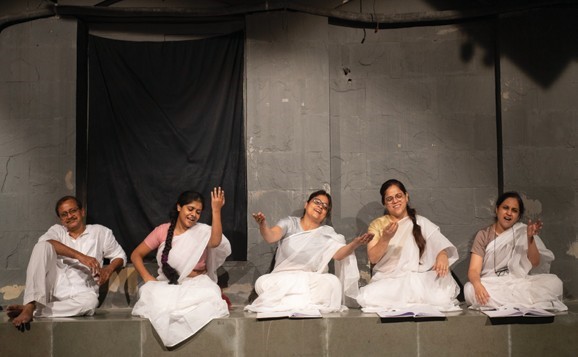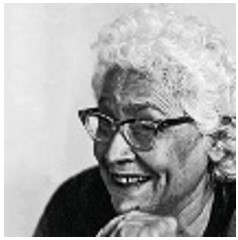 A scene from the play ‘Kaagaz ke Gubbare’
A scene from the play ‘Kaagaz ke Gubbare’
Ismat Chughtai — for those who have read her works, directly or through word-of-mouth or stories – elicits respect as a radical and talented writer of Urdu fiction. Though she would never have liked to be bracketed as a “woman” writer, she really was one. Her writings have a universal flavour and her women are timeless.
Chughtai wrote in her memoir “flowers can be made to bloom among rocks. The only condition is that one has to water the plant with one’s heart’s blood.” She wanted to show to her readers a world clothed in hypocrisy but which was navigable by force of will – not the world she aspired to belong to.
In an innovative venture, Padatik, a theatre group along with Fatehpuria Theatre, that mostly stage plays in Hindi, Urdu and English, recently presented an unusual performance called Kaagaz ke Gubbare directed by Anubha Fatehpuria based on six short stories by Ismat Chughtai.
It turned out to transcend the confines of literature and also theatre to evolve into a mesmerising performance. The actors changed roles and the stories seamlessly flowed one into the other. If you have read Chughtai in translation, you can recognise the stories through the extremely inspired performances by veteran actors from Kolkata’s Hindi-English theatre with their tongue-in-cheek, acidic and caustic lines dotted with a thumri here and a qawwali there with great mastery and finesse that can find place on an international stage.
If you have not read Chughtai, this is a brilliant introduction to this strong feminist writer who, though born in 1915, reads as if she had written the stories yesterday! Fatehpuria who has directed the performance, has taken on the role of Chughtai herself, writing and reading out what she has written, other actors also step into the role of the author as and when need be, reading out from what they have written.
“Ismat Chughtai used her pen as a weapon to question male authority and hierarchical power structure in patriarchy. Most of her works deal with themes directly related to women and their status and role in Indian society. She portrays the struggle of women against oppressive social institutions of her time and her deep understanding and perception of the female psyche are clearly reflected in her writings”, writes Megha
 Another scene from ‘Kaagaz ke Gubbare’
Another scene from ‘Kaagaz ke Gubbare’
Katoria in Women and Sexuality – Gender-Class Interface in Selected Short Stories of Ismat Chughtai (The Criterion: An International Journal in English, Vol.II, Issue IV, December 2011).
The stories picked from the writer’s wonderful oeuvre are – Kunwari, Ek Shauhar Ke Khatir, Chhui Mui, Gharwali, Pesha and Ghoonghat. Each one presents a distinct pointer to women raising their voice, either through speech, or through behaviour, or through their seductive body language, in articulation of their sexual desire in deprivation (Ghoonghat), or, a prostitute who functions at two levels – a virtuous woman by day and a sex worker by night (Pesha). Lajjo, the protagonist of Gharwali who is a woman of precise pleasures.
Pesha is narrated from the perspective of a woman who views courtesans with inexplicable hatred and disdain. Priding herself as belonging to the noble profession of teaching, she professes and practices conventional morality and chastity before marriage. But she is hurled into an identity crisis when a group of tawaifs move into the neighbourhood and try to forge a friendship with her. The story posits the sharp binaries of ‘ideal’ femininity and corrupted womanhood as well as of ‘good’ professions like teaching and “evil ones” like prostitution. The performances are enriched by the electrically charged acting and singing and dancing across the very narrow proscenium space used optimally by the actors.
Chughtai, through her writing, strongly suggested that the sex worker should not give up her profession for the sake of ‘respectability’. She considered sex work to be a legitimate profession – a rather radical and modern element of feminist debates – and stressed more on gaining financial independence and empowerment over conformity to social and moral prescriptions. This is brought across beautifully in Pesha and in Gharwali.
The title of the performance is inspired from the title of Chughtai’s autobiography, Kaagazi Hai Parirahan meaning – Garments are of Paper which Fatehpuria successfully translates through the bodies of the female characters draped in milk-white, translucent and starched saris with the plaits just so, without restricting the movement of the actors in any way and yet evolving into an integral part of the play.
Fatehpuria explained the costume design lucidly.
 Ismat Chugtai
Ismat Chugtai
“Though an attire serves the purpose of covering and protecting at the same time, the paper balloons or the sky lanterns seemed to me to have the same vulnerability because the material being paper, once lit, could rise and fly high – this connected to women in a Sufi way of finding the Self (herself) and her fire within, coming into her own, realising her full potential hence the name Kaagaz ke Gubbare – and therefore also the white Kota sarees which to me gives a papery feeling ; the blouses’ colours are borrowed from the flame that is lit in the paper lanterns which causes them to come alive and fly high” she explained.
She added that in the series she has conceived titled ‘Writers on Stage’ she chose Ismat because she is still relevant, is not so much read by many, she has very strong things to say about women and also to women (not only to men and society). “I found it strong that she is asking women to take charge of their lives and stop complaining about what society has done to them besides the fact that her writing is fabulous, humouristic and packs in a punch,” she adds.
She has chosen her cast and crew with great care and the team generated a magical impact on the mesmerised audience, spilling over with people seated on the floor of the small Padatik Theatre watching in spell-binding silence.
Among them are – Ashok Singh, Kalpana Jha, Palash Chaturvedi, working with Padatik for some time. Adding to their power are Karuna Thakur (of Rangakarmee) and Titas Dutta. Sukrit Sen (the musician) was introduced by Palash. “I did not have the songs in mind in the beginning – I only felt Ismat has musicality in her writings, which motivated me to have these songs and also the emotions and humour I wanted to explore through percussion and not just through performance – hence Sukrit was there to try these out,” she sums up.

